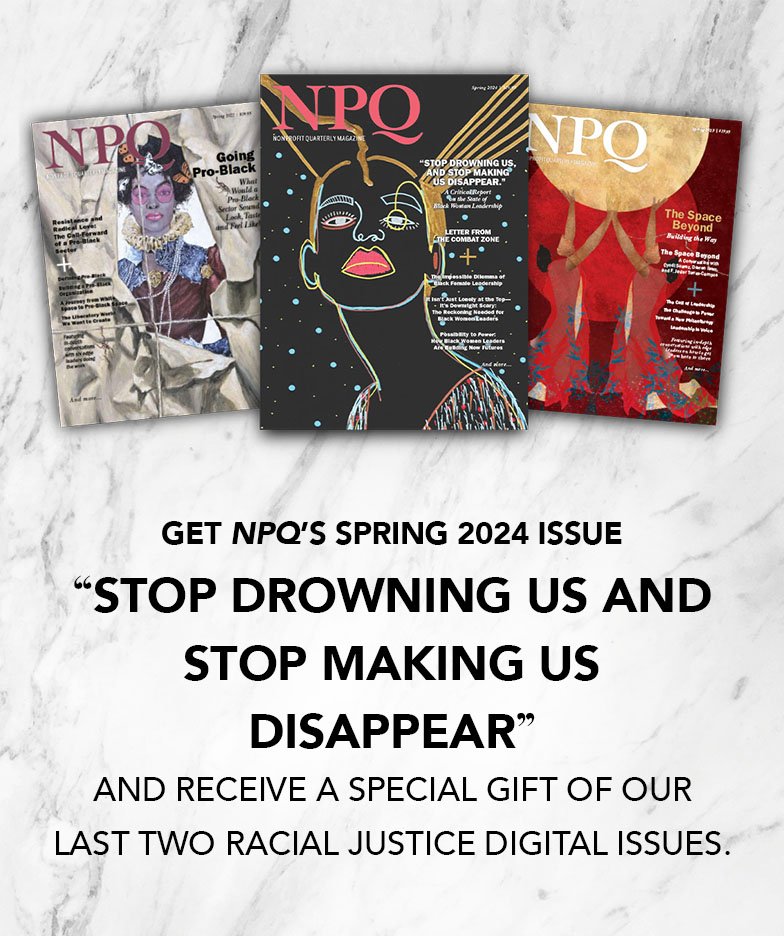
January 29, 2019; Fast Company
A new study, authored by Molly Delano Brennan and Miecha Ranea Forbes of Koya Leadership Partners, an executive search firm that works with nonprofits, surveyed 102 of its clients regarding board diversity for a report titled “The Governance Gap”. In the report, the authors found, as Ben Paynter writes in Fast Company, that “90 percent of board members interviewed said they felt leadership diversity was critical to success, but fewer than 50 percent had taken any steps to boost inclusion among their own boards.”
This finding is unexceptional. The authors themselves note that their findings largely duplicate those of BoardSource’s 2017 “Leading with Intent.” As NPQ pointed out at the time, “With all the talk in recent years…you would think that nonprofits across the country might be prioritizing this issue…[but] diversity has actually declined on nonprofit boards.”
We do wish that when reports like this are written, however, that analysts would up their game. The Fast Company headline illustrates what not to do: “The people running nonprofits continue to be rich, white, and unsure how to change that” it reads. But knowledge is hardly the issue. Nonprofits know—but are they willing to act? Acting requires not simply creating nominating committees, but interrogating core values that make nonprofit organizations white spaces.
Writing last fall in NPQ, Elizabeth Castillo highlights some of the barriers: “Implicitly, these organizations recognize there is a cultural mountain to climb. Their lip service [to equity] means they are fine staying at the homogeneous basecamp rather than risking the ascent to the higher elevation of equity in their own organizations.”
Sign up for our free newsletters
Subscribe to NPQ's newsletters to have our top stories delivered directly to your inbox.
By signing up, you agree to our privacy policy and terms of use, and to receive messages from NPQ and our partners.
Castillo adds that “to develop the collective will to embrace diversity and share power…requires us to invent new ways of doing, being, and relating.” In particular, Castillo says, board propensity to prioritize fundraising over all else must be challenged. Boards looking for new members should consider “intangible and non-monetary resources that prospective members can bring to the organization. Examples of these resources include social capital (relationships in the community), intellectual capital (knowledge of community strengths and needs), cultural capital (familiarity with community norms and values), and political capital (connections to local and regional staff members and elected officials).”
Brennan and Forbes, in their report, acknowledge that “several survey participants mentioned that their boards prioritized fundraising responsibilities over working on strategies to increase diversity.” Their response is to find people of color who have wealth, which is one approach, but that, of course, would lead to a failure to tap into community members of any color or ethnicity who may contribute to the board in a myriad of ways other than fundraising. This suggestion brings with it some stunning assumptions about the requirements of good governance and the realities of fundraising, among other things, and fosters a narrative that’s unfriendly to the growing number of intelligent, discerning people of lesser financial means. It definitely does not take to heart the need to consider the new ways of doing, being, and relating that Castillo raises.
In addition to their survey, Brennan and Forbes outline recruitment strategies. Since Koya is a search firm, this is something they should and do know about. Some suggestions they make are to:
- Work with partners: “Local and regional leadership development networks—such as Coro (a national organization that trains ethical, diverse civic leaders), the NAACP Young Professional Network, and the Young Nonprofit Professional Network (YNPN)—are all good places to build connections and potential pipelines,” Brennan and Forbes explain. (We agree.)
- Tap into staff knowledge: “Though it may sound obvious, it’s rare for boards to ask staff members for input on potential board members. But staff are on the front lines…. Bringing staff into the process of diversifying the board can also be useful in other ways. It can help staff see the board’s commitment and action, create new connections between the board and staff, and bring new ideas to the table.”
- Build the bench: “Create subcommittees or advisory boards that include community members and stakeholders who aren’t full-fledged board members but may be in time, and ensure that these small groups are diverse. This is an excellent way to build a more diverse network for support at the board level and a pipeline for board recruiting in the future.” (An excellent strategy that builds your engagement muscle more generally.)
These strategies can help, but you cannot simply patch in racial equity without engaging in true power sharing and interrogating your organization’s own core values. Some strategies that Brennan and Forbes recommend, such as a breakfast meeting with leaders of color in the community to generate suggestions for board members, could fail spectacularly if the organization has never “shown up” before. Relationship building, of course, takes time, respect, and deep listening.
Bottom line: Building racial equity is possible, and many tactics and strategies can help you get there. But most important of all is being willing to deeply interrogate why your board is not already representative of the community you aim to serve.—Steve Dubb













